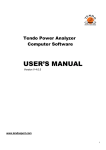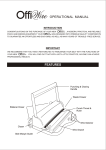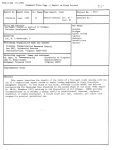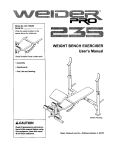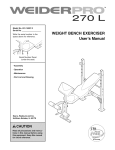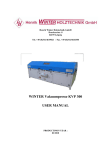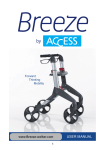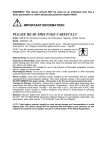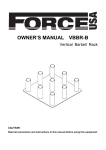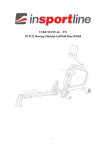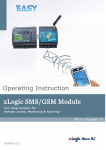Download TENDO P&SA310 manual 112011
Transcript
TENDO Power and Speed Analyzer TENDO PSA310 A microcomputer system for strength diagnostic and feedback monitoring of weight training USER’S MANUAL www.tendosport.com 1 Why use TENDO Power and Speed Analyzer ? One of the most exciting things going on now in athletics is the use of weight training to improve performance in other sports. Weights are used to develop explosive power, maximum strength and muscular endurance, to correct muscular weakness and imbalance, to prevent or rehabilitate injuries and to improve technique and performance in virtually every sport. For example, a person may have a lot of strength at bench press but not be able to do shot put well. He doesn’t have the speed of movement that, combined with strength, generates the necessary power for a long throw. Strength in and of itself does not guarantee high performance. Power is the most important ingredient in many sports. It is an athlete’s ability to rapidly develop strength. It is a product of strength and velocity of muscular contraction. Human muscle is composed of two very general types of fibers: fast-twitch and slowtwitch. All people have both fast-and slow-twitch fibers. Fast- twitch fibers contract faster and can produce more explosive movements, but they fatigue faster. You can not change the ratio of fast-twitch and slow-twitch fibers in your body, but weight training can maximize development of those fast-twitch fibers you do have. Resistance training focused on the improvement of explosive power requires an intensity of exercise close to one’s maximum to guarantee stimulation of all, namely FTG (glycolytic), muscle fibers. The movement must be always at least 90% of max power output measured in watts (Hamar, Bosco). In weight training, particular repetitions in an exercise set with a given weight can be performed at different rates and also with different power output in the concentric phase of muscular contraction. Although the same weight is used, different physiological mechanisms are involved and, hence, different adaptation processes can be expected. Repetitions performed at below a certain critical level of maximum average power (90%)either because of lower motivation or fatigue, do not optimally stimulate development of fast-twitch muscle fibers. The utilization of such a philosophy, supported by TENDO Power and Speed Analyzer, substantially increases the efficiency of resistance training. TENDO Power and Speed Analyzer by TENDO Sports Machines 2 TENDO Power and Speed Analyzer - PSA310 A microcomputer system for strength diagnostic and feedback monitoring of weight training. The purpose of this manual is to guide you through the first basic steps necessary to set up the system and give you an idea how to begin. 1. Instalation steps: 1.1 Connecting to a microcomputer 1. Plug the male connector on your VSU Cable into the connector in the front of the microcomputer 2. Plug the other end of the VSU Cable into the appropriate connector on your Velocity Sensor Unit PSA310. 1.2 Battery Installation Before the microcomputer is operated, 4 “AA” batteries must be installed.(batteries included) Batteries are supplied discharged and must be charged before use. (charger included) Refering to the insert drawing, locate the batteries into compartments on the back of the microcomputer. Press two batteries into each battery compartment. MAKE SURE that the negative ends of the batteries (marked “-“ are touching the springs (marked “-“) in the battery compartment. “Average Power” control LED light should be flashed. If a NET Interface (option) is used, it is not necessary to install the batteries. The power for microcomputer is supplied from the interface. Battery compartments If the microcomputer is turn on and the brightness of LED display is lower, or in upper display flash sign “ Lbat” (law battery power), the batteries need to be charged. 3 It is possible to use external power supply with Regulated AC/DC Adaptor –min. 200mA, output DC 9 – 12V, polarity (+) in the midpoint of connector. Tendo Power and Speed Analyzer Microcomputer Set does not include an External Power Supply Adapter. 2. Technical description The system consists of 2 functional components, a Velocity Sensor Unit and a Microcomputer. Velocity sensor unit is connected to the weight by means of special kevlar cord with strap with velcro. In weight exercise, the muscles lift a mass m by applying a force F (equal to m. g ) at velocity v producing power P (equal to F. v ) The system measures upward vertical average and peak velocity of the weight lifted. Using known mass (input prior to the exercise ), the system calculates average power and the power at peak velocity in concentric phase of weight exercise. The microcomputer with LED displays will show average and peak velocity, average power, power at peak velocity and number of repetition and the percent value of the best repetition in a particular set. 3. How to prepare the system for exercise 3.1 How to connect the velocity sensor unit to barbell or exercise machine: Fasten cord strap of the sensor unit to the bar of the barbell or dumbell, or on the top weight of the weight stack system. Position the cord output of the unit so that the trajectory of the cord is as close to perpendicular to the floor as possible while doing the exercise. 4 3.2 How to set up the microcomputer: Upper display………… Velocity / power button……. Middle display…………………. ON / OFF button………………… Reset button…………… ……… … Lower display… Down button Up button 1. To turn on the power, press the ON/OFF button. 2. When the power is turned on, the lower LED display will begin displaying weight. To adjust the weight of barbell or weight stack, use up/down keys.(press and hold for fast change) 3. After each repetition, its serial number begins displaying lower display, actual value of average (peak) velocity or average (peak) power (choose average, peak power or average, peak velocity by pressing power/velocity button) on the upper display and percent value of the best repetition in a particular set on the middle display (the percent value is displayed for average power or average velocity, only). FILTER Fitler is a way how not to show unwanted motion. FILTER is a limit from 1 to a certain predefined value of range of motion in centimeters which microcomputer ignore (10 centimetres=0.1 meter). It means the exercise range of motion has to be longer than the value of the Filter. For most of the exercises we suggest to set Filter to 35 cm.(less then amplitude of the motion) For exercises with very short amplitude (e.g. toe raise) we suggest to set Filter to 10 cm. For exercises with very long amplitude (Olympic lifting exercises) we suggest to set Filter to more than 80 cm. The microcomputer system measures from the lowest position to the top. The Filter does not have any influence on measured range. The Filter just cause to not show measurement results for motion shorter then the setting value of the Filter. Remember: The value of Filter has to be set less than amplitude of the motion. 3.3 How to adjust the filter and the audio signal: Decrease (increase) of average power or average velocity below (above) a certain predefined percent value of max power (velocity) will be indicated by means of short beep (triple beep). 5 1. Press velocity / power button-hold and press (once)reset button. The upper L.E.D. display will begin displaying the value of the filter in centimeters (from 1 to 150 cm). 2. To adjust the value of the filter ,use up/down keys.(press and hold for fast change) 3. Press velocity / power button. The middle LED display will begin displaying the value of the upper limit of audio signal. 4. To adjust the value of upper limit of audio signal, use up/down keys.(press and hold for fast change) 5. Press velocity /power button and the lower LED display will begin displaying the value of the lower limit of audio signal. 6. To adjust the value of lower limit of audio signal, use up/down keys.(press and hold for fast change) 7. Press reset button. 4. How the microcomputer operates After switching the microcomputer, the weight of the barbell or stack is to be set using up/down keys. After each repetition its serial number (lower display), average or peak velocity in m/s or average or peak power in Watts (upper display) and percent value of the best repetition in particular set will be displayed.(middle display) While performing an exercise set, the average power in the first repetition will be set as 100%.The power of subsequent reps will be displayed also as percent values of this maximum. However, should the second or any subsequent repetition be higher than the previous one, its value will be considered as the new 100%, which all the subsequent reps will be compared to. Data from up to 85 repetitions can be stored and later retrieved from the memory. Pressing the Reset button clears the memory, recalls the weight input mode and makes the system ready for the next exercise set. The microcomputer has a build-in battery saver to prolong the battery life. After 2 minutes of microcomputer rest period, the battery saver is turn on (4 LED lights flashing clockwise) and the microcomputer switch off the displays. The battery saver is turn off automatically by pulling of Velocity Sensor Unit cable, or pressing any key. Do not press Reset or On/Off button. It clears the memory and you will lose all data. 5. How to utilize TENDO Power and Speed Analyzer in practice. 5.1 ATHLETES:-to increase the efficiency of strength training. The athlete has two options for the order in which to perform the exercises prescribed by the coach. First, the athlete may perform all the sets for exercise one then move to the next exercise. Second, the athlete may follow the order of exercises in sequence from the top down, as listed on the daily program sheet. Weight training focused on improvement of explosive power: Resistance training focused on the improvement of explosive power requires intensity of exercise close to one’s maximum to guarantee stimulation of all, namely FTG (glycolytic) muscle fibers. 6 Repetitions performed below a certain critical level of maximum average power (e.g.90%),either because of lower motivation or fatigue, do not optimally stimulate improvement of explosive power. The ability to perform repetitions close to one’s maximum is individual and depends on a variety of factors, namely on an individual ratio of fast- and slow- twitch fibers. In addition, audio signal indicating decrease of average power below critical level (e.g.90%) is available. This should be a signal that muscle fatigue exceeded acceptable level and rest interval is necessary. 1. Connect microcomputer and velocity sensor unit by the cable. 2. Fasten the strap of the velocity sensor unit to the bar of barbell or to upper weight of the weight stack. 3. Position velocity sensor unit on the floor, so that the trajectory of the cable is as close to perpendicular to the floor as possible while doing the exercise. 4. Adjust filter value. 5. Adjust audio signal limits for monitoring fatigue of fast-twitch muscle fibers. Lower limit 90%(decrease of average power below 90% of max average power, will be indicated by means of short beep). Upper limit 100% (if upper limit is 99%,any subsequent repetition with maximum average power is indicated by a triple beep). 6. Set the weight of barbell or resistance of the exercise machine. 7. Choose the exercise to be performed. 8. Perform the exercise with maximum effort. 9. Stop the exercise set after average power decrease below 90%(audio signal indicates decrease of power) . This is a signal that fatigue exceeded an acceptable level and a rest interval is necessary. 10. Take a rest between the sets (approximately 1minutes and 30 seconds) and then perform the exercise set, again. 11. If the intensity of the repetitions at the beginning of the next set is too close to the lower limit(90%), stop the exercise, either because of fatigue or lower motivation do not optimally stimulate improvement of explosive power. 12. Choose another exercise and repeat steps 7 – 10. This way is for an athlete who performs all the sets for each exercise. If the athlete follows the order of exercises in sequences, the most important is to file the value of power in critical level of maximum average power (90%) for each exercise in the first set. Stop the next exercise sets for each exercise after average power decrease below critical level of maximum average power (90%). Do not use the peak power value to monitor muscle fatigue. The average value of power or velocity is more sensitive parameter to monitor muscle fatigue. Weight training focused on improvement of the muscular endurance Resistance training focused on the improvement of muscular endurance requires intensity of exercise below a certain critical level of maximum average power (80 %).This intensity ensures not to recruit fasttwitch muscle fibers. (glycolytic) Set upper limit of audio signal to 80%.(increase in power above 80% of max average power is indicated by triple beep) Set lower limit of audio signal to 60%.(decrease in average power below 60% of max average power is indicated by single beep) Perform first and second repetition of the exercise set with maximum effort and next repetitions perform within 80% and 60% of the maximum average power. 7 5.2 COACHES –quick test set up for assessment of athlete’s strength abilities How to find out the optimum weight for maximum power A typical test routine consists of maximum effort repetitions with an incremental increase in weight up to 1 RM. For instance, in bench press, an initial weight of 50 lb is to be increased by 20 lb at the beginning. As the weight approaches 1 RM, smaller increases (10 lb or 5 lb )may be more appropriate. From each repetition, mass, average (peak) velocity and average (peak) power should be recorded. Using these data, the individual velocity-weight as well as power-weight curves can be drawn. FIG.6.Velocity-weight and power-weight curves based on data collected from all-out reps with different weights Such an approach provides more sensitive method for detection of specific adaptation changes due to different forms of weight training (e.g. slow or fast) than the estimation of 1 RM Studies show that maximum average power, the subject can produce by using weights that are 50% of 1 RM , represents a substantially more sensitive parameter for the assessment of strength training than 1 RM itself. 5.3 WEIGHTLIFTING EXERCISES It is important to set up the right value of the Filter for weightlifting exercises. (see table 1) Table 1 Exercise name Filter value Exercise name Filter value Power Snatch Power Clean Jerk Clean Pull Snatch Pull Hang Clean Hang Snatch 70-90 cm 70-90 cm 30-40 cm 30-40 cm 30-40 cm 30-40 cm 30-40 cm Squat Bench press Toe raise 30-40 cm 30-35 cm 8-12 cm 8 6. MAINTENANCE and TROUBLE-SHOOTING The TENDO Power and Speed Analyzer can be cleaned with a soft, damp cloth. Avoid spilling liquid on the microcomputer and velocity sensor unit. Keep the microcomputer out of direct sunlight. Remove the batteries when storing the Power and Speed Analyzer. If the microcomputer does not function properly - the batteries should be charged. - In addition, make sure that the microcomputer wire is connected to the velocity sensor unit. Check the Filter. The value of Filter has to be set less than amplitude of the motion !!! For indoor use, only. Do not let the cord with strap of the Velocity Sensor Unit rolls spontaneous. The TENDO Power and Speed Analyzer package includes: 1. Microcomputer 2. Velocity sensor unit 3. Tripod 4. Set of rechargeable batteries 5. Battery charger 6. Carrying bag Tendo Power and Speed Analyzer can also be interfaced with a computer to run up to 8 stations simultaneously. Computer software and interface is the same as for the Tendo Weightlifting Analyzer and is an additional option in this model. 9 The Tendo Unit in Practice How to fasten the Sensor Unit Outer end of barbell Weight Stack grip section Leg Press machine Manufactured in Europe. TENDO Sports Machines M.R. Stefanika 19 911 01 Trencin Slovak Republic Phone / fax : 00421-32-6401500 e-mail:[email protected] www.tendosport.com 10













